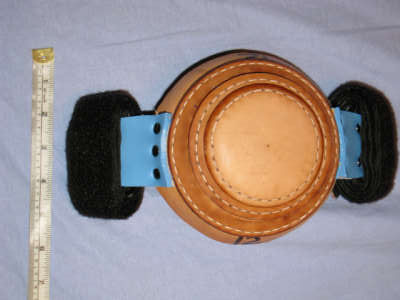What are bell muffles?
Leather pads attached to the clappers of bells hung for “full circle” ringing in the English style, to produce a muffled effect.
What is half-muffled ringing?
A muffle is attached to one side of the clapper of each bell, so that all the bells sound “open” (i.e. loud) on the handstroke and muffled (softer) on the backstroke giving an echo effect.
When are bells rung half-muffled?
Traditionally for Remembrance Sunday, for funerals and on the deaths of prominent national or local figures. They may also be rung as mark of respect to the victims of natural disasters, terrorist attacks etc.
Are bells ever rung fully-muffled?
Only on the death of the Sovereign or, by local custom in one or two places, also on Good Friday. [This requires two sets of muffles, one for each side of the clapper.] The tenor bell may be left open at backstroke which produces a solemn tolling effect.

What is special about Big Wilf’s muffles?
Traditional muffles are attached with straps and buckles or sometimes leather thongs. Big Wilf’s muffles use an industrial velcro fastening, making them much easier to put on and take off.
Are they suitable for all bells?
Big Wilf’s muffles are made to measure and can be supplied to fit most bells. The standard design is suitable for all normal clappers with a spherical ball and medium to long flight. However, a few bells have unusually shaped clappers - e.g. short flights, “mushroom” heads or pear-shaped balls [See clappers]. If this is the case, please contact us to discuss your requirements. We can usually find a solution, although it may cost a little more.
Are they as secure as traditional muffles?
Yes, and more so, providing the instructions are followed.
Do the bells need any preparation for using Big Wilf’s muffles?
We recommend that all clappers are painted with a non-slip paint to prevent slippage, the only exception being square wooden shafted clappers.
Which side of the clapper should a muffle be attached?
To muffle a bell at backstroke, the leather pad should be on the side opposite the garter hole.
Who uses Big Wilf’s muffles?
To date, over 1000 towers worldwide, including Westminster Abbey, Exeter, Canterbury, Birmingham, Southwark, Worcester, Durham, Chelmsford and Glasgow Cathedrals, St Mary-le-Bow, St Mary Redcliffe, Sherborne Abbey, St James Garlickhythe (the Royal Jubilee Bells), Trinity Church, New York and Singapore Cathedral.
What is the biggest muffle we have made?
The muffle for Grandison, the 72 cwt tenor bell at Exeter Cathedral, (see picture below) is the biggest - so far.
